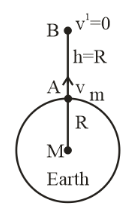
Answer
460.8k+ views
Hint:In order to solve this problem, first use the concept that at the maximum height point, the velocity of the body becomes zero. After then use the conservation of energy at points A and B. Where point A is the point of earth surface from which body was projected and point B is the maximum height point from which body comes back to earth.
Complete step by step answer:
Let the velocity of the body with which it was projected be V and radius of earth is R and mass M.

And given that the height attained by the body is equal to R.
We know that at maximum height point the velocity of the body becomes zero.
Now applying conservation of energy at the surface and at a height $h = R$
\[\Rightarrow {(K.E.)_A} + {(P.E.)_A} = {(K.E.)_B} + {(P.E.)_B}\]
$\Rightarrow \dfrac{1}{2}m{v^2} + \left( {\dfrac{{ - GMm}}{R}} \right) = 0 + \left( {\dfrac{{ - GMm}}{{2R}}} \right)$
$\Rightarrow \dfrac{1}{2}m{v^2} - \dfrac{{GMm}}{R} = \dfrac{{ - GMm}}{{2R}}$
$\Rightarrow \dfrac{1}{2}m{v^2} = \dfrac{{ - GMm}}{{2R}} + \dfrac{{GMm}}{R}$
$\Rightarrow \dfrac{1}{2}m{v^2} = \dfrac{{GMm}}{{2R}}$
$\Rightarrow {v^2} = \dfrac{{2GMm}}{{2mR}}$
$\Rightarrow {v^2} = \dfrac{{GM}}{R}$
$\therefore v = \sqrt {\dfrac{{GM}}{R}} $
So, the velocity of the body with which it was projected is $\sqrt {\dfrac{{GM}}{R}} $.
Hence, option A is the correct answer.
Note: In order to solve gravitational or satellite problems 2 methods are used.
1. Energy conservation method.
2. Equate centripetal force with the gravitational force.
i.e., $\dfrac{{m{v^2}}}{R} = \dfrac{{GMm}}{{{R^2}}}$
Complete step by step answer:
Let the velocity of the body with which it was projected be V and radius of earth is R and mass M.

And given that the height attained by the body is equal to R.
We know that at maximum height point the velocity of the body becomes zero.
Now applying conservation of energy at the surface and at a height $h = R$
\[\Rightarrow {(K.E.)_A} + {(P.E.)_A} = {(K.E.)_B} + {(P.E.)_B}\]
$\Rightarrow \dfrac{1}{2}m{v^2} + \left( {\dfrac{{ - GMm}}{R}} \right) = 0 + \left( {\dfrac{{ - GMm}}{{2R}}} \right)$
$\Rightarrow \dfrac{1}{2}m{v^2} - \dfrac{{GMm}}{R} = \dfrac{{ - GMm}}{{2R}}$
$\Rightarrow \dfrac{1}{2}m{v^2} = \dfrac{{ - GMm}}{{2R}} + \dfrac{{GMm}}{R}$
$\Rightarrow \dfrac{1}{2}m{v^2} = \dfrac{{GMm}}{{2R}}$
$\Rightarrow {v^2} = \dfrac{{2GMm}}{{2mR}}$
$\Rightarrow {v^2} = \dfrac{{GM}}{R}$
$\therefore v = \sqrt {\dfrac{{GM}}{R}} $
So, the velocity of the body with which it was projected is $\sqrt {\dfrac{{GM}}{R}} $.
Hence, option A is the correct answer.
Note: In order to solve gravitational or satellite problems 2 methods are used.
1. Energy conservation method.
2. Equate centripetal force with the gravitational force.
i.e., $\dfrac{{m{v^2}}}{R} = \dfrac{{GMm}}{{{R^2}}}$
Recently Updated Pages
Fill in the blanks with suitable prepositions Break class 10 english CBSE

Fill in the blanks with suitable articles Tribune is class 10 english CBSE

Rearrange the following words and phrases to form a class 10 english CBSE

Select the opposite of the given word Permit aGive class 10 english CBSE

Fill in the blank with the most appropriate option class 10 english CBSE

Some places have oneline notices Which option is a class 10 english CBSE

Trending doubts
Fill the blanks with the suitable prepositions 1 The class 9 english CBSE

How do you graph the function fx 4x class 9 maths CBSE

When was Karauli Praja Mandal established 11934 21936 class 10 social science CBSE

Which are the Top 10 Largest Countries of the World?

What is the definite integral of zero a constant b class 12 maths CBSE

Why is steel more elastic than rubber class 11 physics CBSE

Distinguish between the following Ferrous and nonferrous class 9 social science CBSE

The Equation xxx + 2 is Satisfied when x is Equal to Class 10 Maths

Differentiate between homogeneous and heterogeneous class 12 chemistry CBSE




